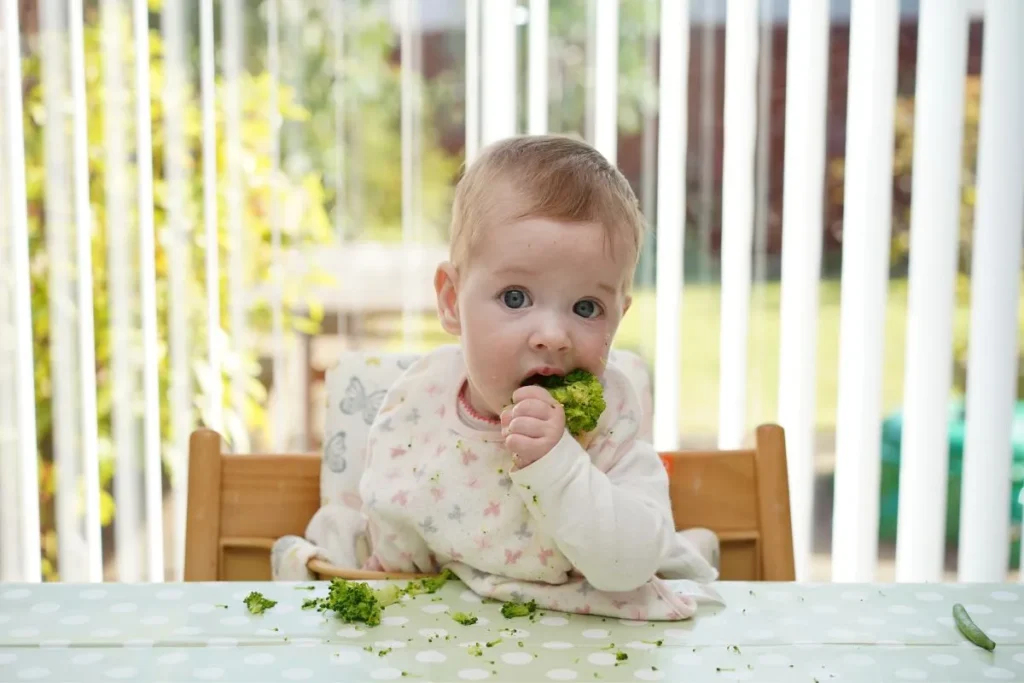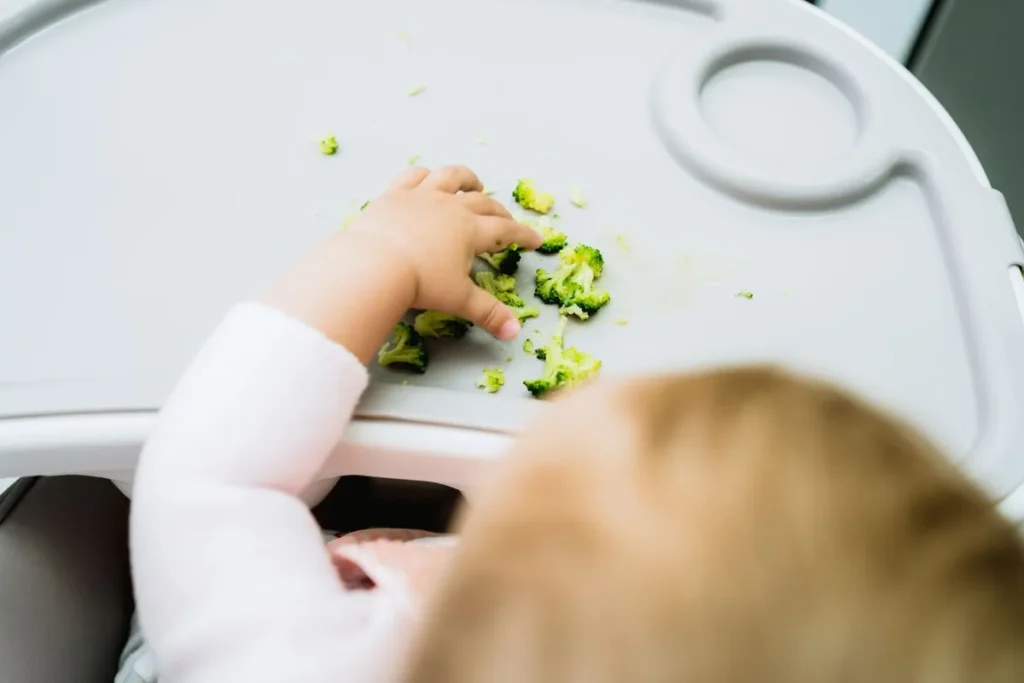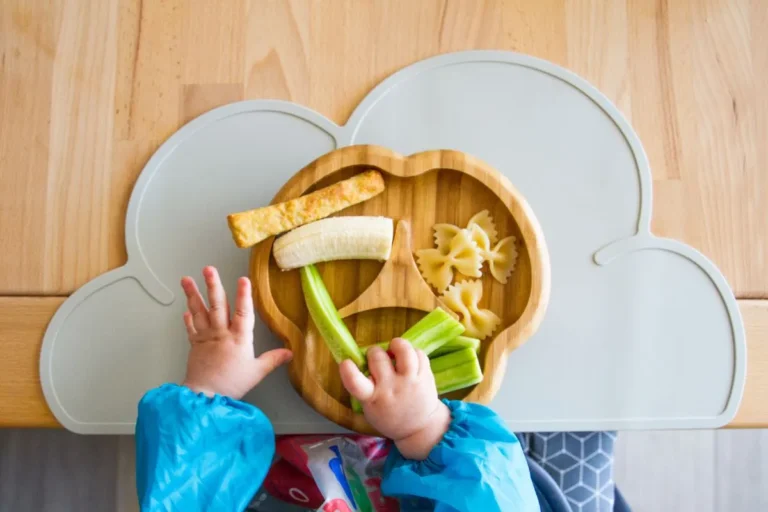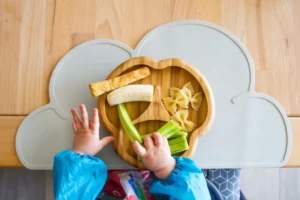There autonomous food diversification is a method of introducing solid foods to babies that is gaining popularity, especially among modern parents. It differs from traditional approaches by giving babies the freedom to explore food on their own, without direct parental intervention. By allowing your child to grasp, smell, and taste foods at their own pace, this method stimulates their development while introducing them to healthy eating from the start. But what are the real benefits of this method, and how can you make sure it goes smoothly? Let’s find out the details together.

What is Divers
Independent weaning is based on a simple but powerful idea: letting your baby lead his or her own weaning process, rather than spoon-feeding purees. Unlike traditional methods where parents prepare purees and spoon-feed their child, independent weaning involves introducing solid foods in small, age-appropriate pieces. Your child then picks up the food with his or her hands and brings it to his or her mouth, exploring textures and flavors at his or her own pace.
This method is based on the principle that babies are naturally curious and able to manage the transition to solid foods on their own, without direct parental intervention. It is about trusting the child and encouraging them to discover food in an active rather than passive way.
Why Choose Autonomous Food Diversification?
One of the main attractions of independent feeding is that it allows babies to quickly develop a variety of skills, both motor and cognitive. When babies use their hands to pick up food and bring it to their mouths, they work on hand-eye coordination, fine motor skills, and spatial awareness. Plus, this approach encourages full sensory exploration: babies discover not only the taste of food, but also its texture, smell, and appearance.
Another benefit is that it can reduce the chances of becoming a picky eater in the future. By exposing children to a wide range of foods early on, they are more likely to develop a more diverse palate. Unlike purees, where foods are often mixed together, independent weaning allows children to taste foods individually, which helps them develop a preference for the natural flavors of fruits, vegetables, meats, and other healthy foods.
For parents, independent weaning also has a practical benefit. Rather than spending time preparing specific purees for your baby, you can simply give your baby pieces of what you eat yourself, with a few adjustments to ensure safety. This makes family meals much easier and allows your child to participate in meals with the rest of the family.
The Challenges of Autonomous Food Diversification
Like any parenting approach, independent weaning also comes with its challenges. One of the most common concerns is the risk of choking. However, with the right precautions, this risk can be minimized. It is essential to ensure that foods are cut into small pieces and are soft enough for the baby to chew or crush with their gums. For example, cooked carrot sticks, banana chunks, or avocado slices are great choices to start with.
Additionally, it is important to always supervise your baby while eating. While independent solid food encourages independence, young children should be closely supervised during mealtimes to ensure they are eating safely.
Another challenge is mess. Yes, independent feeding can be messy! Babies love to explore food, which means that much of what they touch often ends up on the table, the floor, or even on themselves. So it's a good idea to prepare for this reality by investing in some waterproof bibs, easy-to-clean tablecloths and placing wipes within easy reach.

How to Start with Independent Food Diversification?
If you're convinced by the benefits of independent weaning and want to give it a try, it's important to know when and how to start. Most experts recommend waiting until your baby is about six months old before introducing solid foods, as this is typically the age when babies are physically ready for this new milestone. Signs that your baby is ready include being able to sit up unassisted, putting objects in his or her mouth, and showing interest in the food you're eating.
Once you're ready to start, introduce foods that are easy for your baby to handle. Cooked vegetables, pieces of ripe fruit, or even well-cooked cuts of meat can be good options. Make sure the foods are the right size and consistency to avoid any choking hazards. For example, cut foods into sticks or pieces that your baby can easily grasp with their little hands.
The key is to let your baby explore foods at his own pace. It's important not to expect him to eat a lot right away. In fact, in the first few weeks, your baby may simply taste and play with food rather than consuming it in large quantities. This process of exploration is essential for developing a healthy relationship with food.
How to Manage Common Worries?
As mentioned earlier, one of the major concerns of parents is the risk of choking. While this risk does exist, it can be greatly reduced by taking proper safety precautions. Make sure your baby is always sitting upright when eating and that he has foods that are appropriate for his age and abilities. Avoid hard, round or sticky foods that could obstruct the airway.
Independent weaning can also raise concerns about how much your baby is eating. It’s normal for parents to wonder if their baby is getting enough. However, it’s important to remember that breast milk or formula is still the primary source of nutrition until 12 months of age. Solids are just a supplement to this basic diet, and your baby will get everything they need as long as they continue to drink enough milk.
If you have any doubts or concerns, do not hesitate to consult your pediatrician. He or she will be able to provide you with personalized advice based on your baby's specific needs.
Conclusion
Ultimately, independent weaning is a method that allows babies to take control of their own eating from the beginning. It promotes independence, self-confidence, and a positive relationship with food. While it may be a little messier than traditional methods, the long-term benefits are well worth it.
Every family is unique, and what works for one family may not work for another. If you are interested in independent weaning, it is important to remain flexible and do what works best for your child. With a little patience and preparation, this approach can turn mealtimes into moments of learning, fun, and discovery for the whole family.

























